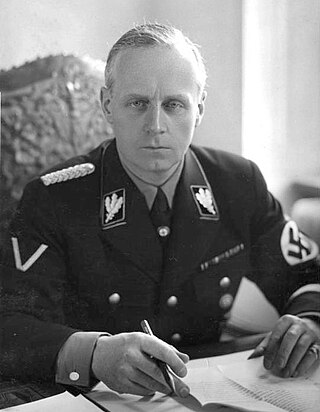
Ulrich Friedrich-Wilhelm Joachim von Ribbentrop was a German politician and diplomat who served as Minister of Foreign Affairs of Nazi Germany from 1938 to 1945.
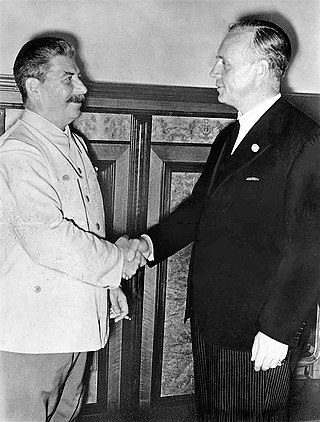
The Molotov–Ribbentrop Pact, officially the Treaty of Non-Aggression between Germany and the Union of Soviet Socialist Republics, was a non-aggression pact between Nazi Germany and the Soviet Union with a secret protocol that partitioned Central and Eastern Europe between them. The pact was signed in Moscow on 23 August 1939 by German Foreign Minister Joachim von Ribbentrop and Soviet Foreign Minister Vyacheslav Molotov. Unofficially, it has also been referred to as the Hitler–Stalin Pact, Nazi–Soviet Pact, or Nazi–Soviet Alliance.

Ernst Heinrich Freiherr von Weizsäcker was a German naval officer, diplomat and politician. He served as State Secretary at the Foreign Office of Nazi Germany from 1938 to 1943, and as its Ambassador to the Holy See from 1943 to 1945. He was a member of the prominent Weizsäcker family, and the father of German President Richard von Weizsäcker and physicist and philosopher Carl Friedrich von Weizsäcker.
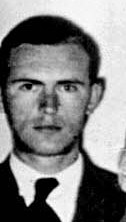
Richard Schulze-Kossens was a Nazi Party member and SS commander during the Nazi era. Before and during World War II, he served as a personal adjutant to foreign minister Joachim von Ribbentrop. He also served at different intervals, as an ordinance officer and SS adjutant for Adolf Hitler and later commanded the SS Division Nibelungen, SS-Junkerschule Bad Tölz. After the war in Europe ended, he was held in an American internment camp for three years and died in 1988.

Martin Franz Julius Luther was a German diplomat. An early member of the Nazi Party, he served as an advisor to Foreign Minister Joachim von Ribbentrop, first in the Dienststelle Ribbentrop, and later in the Auswärtiges Amt as a diplomat when von Ribbentrop replaced Konstantin von Neurath. He participated in the January 1942 Wannsee Conference, at which the genocidal Final Solution to the Jewish Question was planned; it was the 1947 discovery of his copy of the minutes that first made the Allied powers aware that the conference had taken place and what its purpose was.

The Federal Foreign Office, abbreviated AA, is the foreign ministry of the Federal Republic of Germany, a federal agency responsible for both the country's foreign policy and its relationship with the European Union. It is a cabinet-level ministry. Since December 2021, Annalena Baerbock has served as Foreign Minister, succeeding Heiko Maas. The primary seat of the ministry is at the Werderscher Markt square in the Mitte district, the historic centre of Berlin.

Heinrich Hoffmann was Adolf Hitler's official photographer, and a Nazi politician and publisher, who was a member of Hitler's intimate circle. Hoffmann's photographs were a significant part of Hitler's propaganda campaign to present himself and the Nazi Party as a significant mass phenomenon. He received royalties from all uses of Hitler's image, which made him a millionaire over the course of Hitler's rule. After the Second World War he was tried and sentenced to 10 years in prison for war profiteering. He was classified by the Allies' Art Looting Investigators to be a "major offender" in Nazi art plundering of Jews, as both art dealer and collector and his art collection, which contained many artworks looted from Jews, was ordered confiscated by the Allies. Hoffmann's sentence was reduced to 4 years on appeal. In 1956, the Bavarian State ordered all art under its control and formerly possessed by Hoffmann to be returned to him.
Paul Carell was the post-war pen name of Paul Karl Schmidt who was a writer and German propagandist. During the Nazi era, Schmidt served as the chief press spokesman for Joachim von Ribbentrop's Foreign Ministry. In this capacity during World War II, he maintained close ties with the Wehrmacht, while he served in the Allgemeine-SS. One of his specialities was the "Jewish question". After the war, Carell became a successful author whose books romanticized and whitewashed the Wehrmacht. Some may disagree with this view, arguing that nowhere in Carrell's two-volume work on the Russo-German War, is there any mention of glorifying Hitler or Nazism. In fact, Carrell/Schmidt criticises Hitler many times throughout.

Hotel Berlin is an American drama film set in Berlin near the close of World War II, made by Warner Bros. in late 1944 to early 1945. Directed by Peter Godfrey, it stars Faye Emerson, Helmut Dantine, Raymond Massey and Andrea King. It is based on the novel Hotel Berlin by Vicki Baum, a sequel to Menschen im Hotel, which was itself adapted to film as Grand Hotel (1932).

The Associated Press (AP) is an American not-for-profit news agency headquartered in New York City. Founded in 1846, it operates as a cooperative, unincorporated association, and produces news reports that are distributed to its members, major U.S. daily newspapers and radio and television broadcasters. Since the award was established in 1917, the AP has earned 58 Pulitzer Prizes, including 35 for photography. The AP is also known for its widely used AP Stylebook, its AP polls tracking NCAA sports, and its election polls and results during US elections.

Falsifiers of History was a book published by the Soviet Information Bureau, edited and partially re-written by Joseph Stalin, in response to documents made public in January 1948 regarding German–Soviet relations before and after the Molotov–Ribbentrop Pact.

Raising a Flag over the Reichstag is an iconic World War II photograph, taken during the Battle of Berlin on 2 May 1945. It depicts a Soviet soldier raising the flag of the Soviet Union over the Reichstag building. The photograph was reprinted in thousands of publications and came to be regarded around the world as one of the most significant and recognizable images of World War II. Owing to the secrecy of Soviet media, the identities of the men in the picture were often disputed, as was that of the photographer, Yevgeny Khaldei. It became a symbol of the Soviet victory over Nazi Germany.
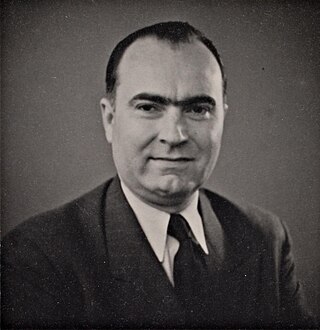
Helmut Roland Heinrich Pfeiffer was a German lawyer and SS officer who rescued people hunted by the Nazi regime.
Edgar von Spiegel von und zu Peckelsheim was a German submarine commander in World War I, Consul in New Orleans and Marseille in World War II and writer. He wrote several, mainly autobiographical naval warfare books. The most successful one was “Kriegstagebuch U 202“. It sold 360,000 copies in Germany and was also a success in the United States.
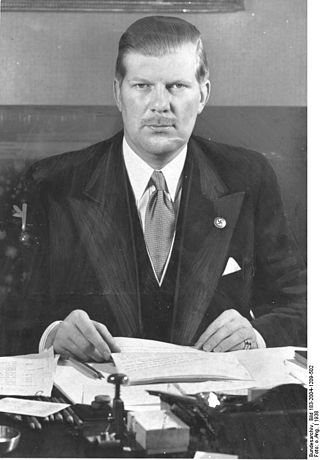
Alexander Freiherr von Dörnberg zu Hausen was a German jurist, diplomat and SS officer. He was head of the Protocol Department of the Foreign Office from 1938 to 1945.
Carltheo Zeitschel also Carl Theo,, was a German physician, diplomat, Nazi functionary and SS-major (1940).

Alfred Zech, also known as Alfred Czech, was a German child soldier who received the Iron Cross, 2nd Class at the age of 12 years.













